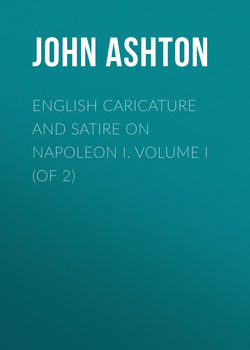English Caricature and Satire on Napoleon I. Volume I (of 2)

Реклама. ООО «ЛитРес», ИНН: 7719571260.
Оглавление
Ashton John. English Caricature and Satire on Napoleon I. Volume I (of 2)
CHAPTER I
CHAPTER II
CHAPTER III
CHAPTER IV
CHAPTER V
CHAPTER VI
CHAPTER VII
CHAPTER VIII
CHAPTER IX
CHAPTER X
CHAPTER XI
CHAPTER XII
CHAPTER XIII
CHAPTER XIV
CHAPTER XV
CHAPTER XVI
CHAPTER XVII
CHAPTER XVIII
CHAPTER XIX
CHAPTER XX
CHAPTER XXI
CHAPTER XXII
CHAPTER XXIII
CHAPTER XXIV
CHAPTER XXV
CHAPTER XXVI
CHAPTER XXVII
CHAPTER XXVIII
CHAPTER XXIX
CHAPTER XXX
CHAPTER XXXI
CHAPTER XXXII
CHAPTER XXXIII
CHAPTER XXXIV
CHAPTER XXXV
CHAPTER XXXVI
CHAPTER XXXVII
Отрывок из книги
Curiously enough, it has never been practically settled whence the ancestors of Napoleon Bonaparte came. He, himself, cared little for the pride of birth, and when, during his Consulate, they manufactured for him a genealogy descending from a line of kings, he laughed at it, and said that his patent of nobility dated from the battle of Montenotte.
But, still, one would think he ought to know, for family tradition is strong; and if it can be trusted, this is his own account. ‘One day Napoleon questioned Canova about Alfieri, and Canova found an opportunity to render an important service to Florence, &c. “Sire,” said he, “authorise the President of the Academy of Florence to take care of the frescoes and pictures. I heartily wish it. That will reflect great honour on your Majesty, who, I am assured, is of a noble Florentine family.” At these words the Empress (Maria Louisa) turned towards her husband and said: – “What! are you not Corsican?” “Yes,” replied Napoleon, “but of Florentine origin.” Canova then said: – “The President of the Academy of Florence, the Senator Allessandria, is of one of the most illustrious houses in the country, which has had one of its ladies married to a Bonaparte, thus you are Italian, and we boast of it.” “I am, certainly,” added Napoleon.’1
.....
In a curious little book called The Corsican’s Downfall, by a Royal Arch Mason, published at Mansfield in 1814, at p. 6, it says, with reference to the numeration, ‘The oldest treatise on the theory of arithmetic is comprised in the seventh, eighth, and ninth books of Euclid’s Elements, about two hundred and eighty years before the Christian era. The first author of any consequence who used the modern way of computing by figures, instead of letters of the alphabet, was Jordanus of Namur, who flourished about 1200; and his arithmetic was afterwards published and demonstrated by Johannis Faber Stapulensis, in the fifteenth century. The name, then, and number of the Beast must be discovered (if at all) by the ancient method of computation in use at the time when the prophecies were written.’
But Bonaparte ungratefully refused to fulfil prophecy by being destroyed at the end of forty-two months, i. e. in June 1808, which must have put the expositors on their mettle. They were, however, fully equal to the occasion, and ingeniously solved the quotation this way.11 ‘Power was given unto him to continue forty-and-two months: now it is well known that he was self created, or crowned Emperor of France, on the 2nd day of December 1804, and that he reigned in full power and authority over the prostrate States upon the Continent until the 2nd day of May 1808, the very day on which the gallant Patriots of Spain made so noble and glorious a struggle to throw off the abominable yoke that he had imposed upon them, which is exactly a period of three years and a half, or forty two months.’
.....